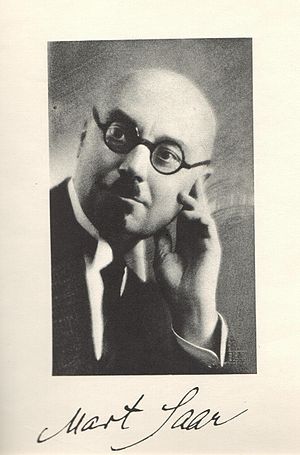|
Mart Saar
Mart Saar (28 September [O.S. 15 September] 1882 in Hüpassaare – 28 October 1963) was an Estonian composer, organist and collector of folk songs. Childhood Saar was born in the small borough of Hüpassaare[1] (now in Karjasoo, Suure-Jaani Parish), Kreis Fellin in the Livonian Governorate of the Russian Empire (now Estonia), to Mihkel and Ann Saar (née Kimmel). His father was employed in the forestry business. He was the eldest of fours siblings; Anna (1885–1968), Hans (1895–1979) and Jaan (1897–1898). He received his education in the village school at Kaansoo and the Suure-Jaani Parish school. His music teacher in the Suure-Jaani parish school was Joosep Kapp, the father of Artur Kapp, another famous Estonian composer.[1] In addition, Saar's father was a talented organist, who gave him lessons at home. Adult lifeIn 1901, Saar left home to study music at the Saint Petersburg Conservatory.[1] He graduated in 1908 but chose to continue his studies. After graduation in 1911, he became a music teacher in Tartu. Ten years later, in 1921, he moved to Tallinn, Estonia as a freelance composer and organist. He spent his summers in his native borough Hüpassaare. In August 1915, he married Elise Paalmann. The couple had two children; a daughter Heli (1917–1975) and a son, Ülo (1927–1945). The marriage ended in divorce when Elise moved to the United States in 1937, initially expecting Saar to join her. However, Saar decided that he did not wish to leave Estonia. Saar later married Magda Elisabeth Takk and had a daughter named Tuuli.[2] CareerEarly in his career, Saar was influenced by the European music of the early 19th century. Later in his life, Saar combined Estonian folk music with more contemporary sounds. In addition to composing, Saar also wrote lyrics to some of his songs. Usually, these lyrics express a love for Estonia and nature. They also address the brevity of life. Saar's lyrics have been compared to the poetry of Anna Haava and Juhan Liiv. Selected worksWorks for mixed chorus include:
Works for male choir include:
Works for female choir include:
Solo songs include:
Piano music includes:
References
|
